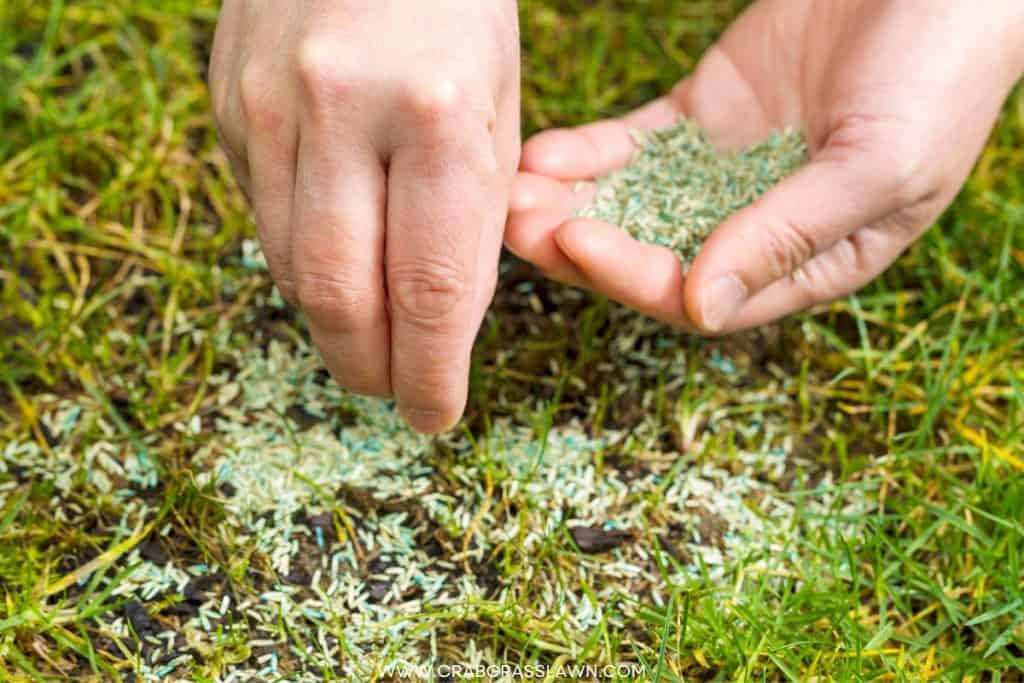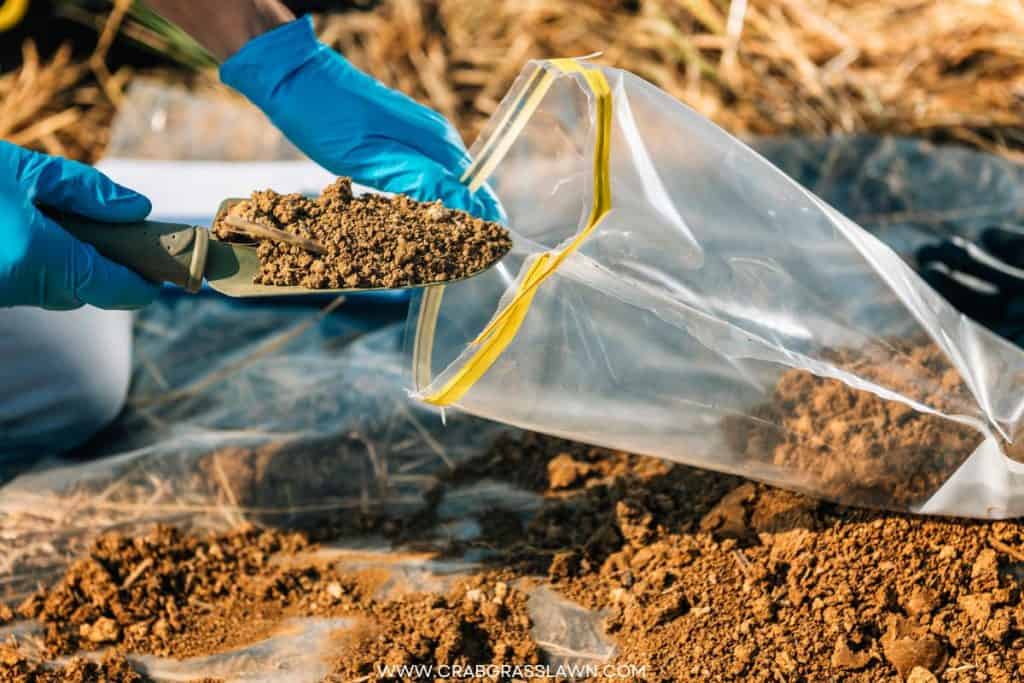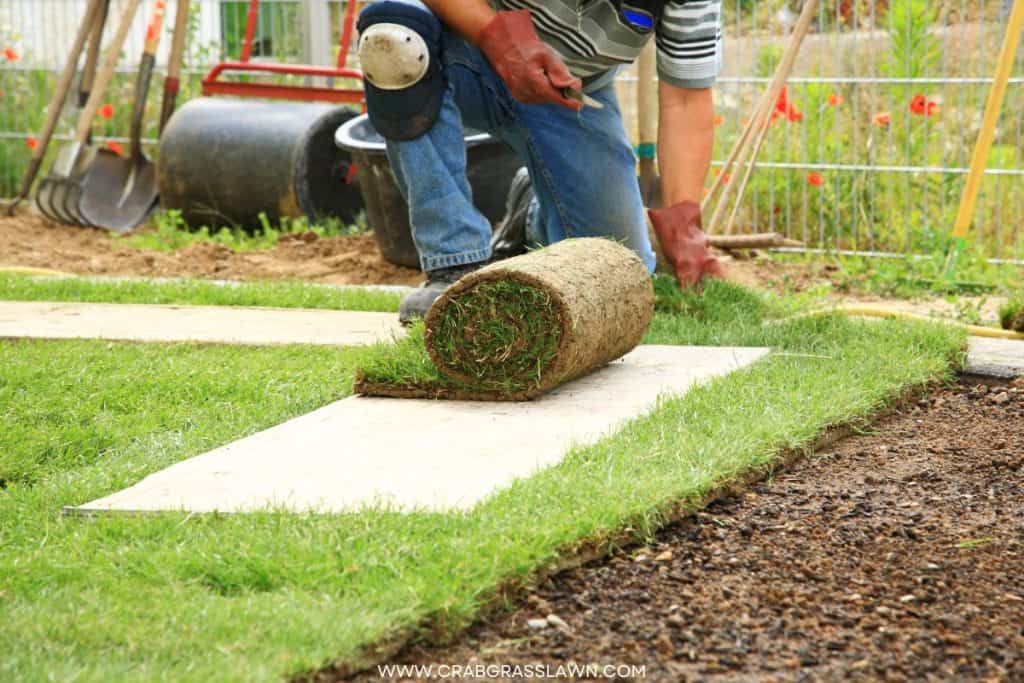Even though it may be tempting to spread new grass seed or lay down sod over your current lawn, I don’t recommend it for basically the same reason why you don’t hang new wallpaper over an old one!
Maintaining a lawn requires a fair bit of effort such as providing your turf with the right nutrients at the right time, proper watering schedule, eliminating weeds, and ensuring the soil is in check.
However, even after caring for your grass plants with the best fertilizer, problems like thinning, bare patches, or bare spots can occur, resulting in the need to plant grass seed on an existing lawn.
You can plant grass over an existing lawn, but there’s a right way to perform the task. So without ado, here’s a detailed guide on the steps to correctly plant new grass seed on top of old turfgrass.
Why You Shouldn’t Plant Grass Seed on Existing Lawn?
If you’re seriously thinking of planting grass seed on an existing lawn, there’s got to be a good reason for it. Perhaps a good reason is that your current lawn has lumps and bumps on the ground, is pale and blotchy, and is simply worn out.
But all these issues have an underlying cause, which more often than not lies in the soil underneath.
So if you lay new grass seed on an existing lawn, you’re not curing the underlying issues, but are simply hiding those issues.
Take a look at my wallpaper analogy. If my old wallpaper is lifting off the wall or damp, sticking a new one over it won’t solve that issue because the area is still damp, and my new wallpaper will eventually bubble and peel off.
Although laying new grass over old grass may be a good time-saving idea, and you may even get some good results initially, the health of your new grass will begin to deteriorate as the old grass dies.
Getting back to the big question – should you plant new grass seed on the existing lawn, the answer is no, but you should renovate your current lawn instead, which means making soil amendments, fixing soil issues much below the top couple of inches of soil, aerating, top dressing and overseeding. Here are a few tips on how to care for your soil in an environmentally friendly way.

Planting New Grass Instead
Manure vs. Black Dirt for a New Lawn
Before installing a new lawn, you’ll have to amend the soil to suit your new grass species system and requirements. When speaking of soil amendments, manure, and black dirt are often used interchangeably, but they aren’t the same thing.
Similarly, people often use the words black dirt and topsoil interchangeably because they both look the same, but the former typically contains iron and other chemicals, and the latter is rich in organic material, including decomposing plant and animal material as well as nutrients.
Manure feeds your new lawn with nitrogen and also creates a new, healthy environment for your new grass. Adding black dirt addresses compacted soil issues, and replenishes nutrients that your grass type craves.

Evaluate Your Lawn
The first thing to do is evaluate your lawn and perform certain tasks including dethatching and core aeration. Do you know the right time to aerate soil?
Adding to this, if your existing lawn is riddled with weeds, your best bet is to get rid of the old turf completely and plant fresh grass.
When evaluating your lawn, there are a few things to think of such as what could be causing, the brown patches, thin spots, or bare circular patches.
The causes of these turf issues can be caused by:
- Soil compaction,
- A fungal problem,
- Poor sunlight,
- Poor soil condition,
- Excess thatch,
- or improper drainage.
Additionally, it’s also important to carefully select the new grass you’ll plant on your lawn to ensure that it’s able to thrive in your neck of the woods.
Preparing the Lawn
There are 3 important things to do before overseeding your lawn namely: dethatching, mowing, and aerating using a core aerator.
- Start by mowing your lawn to half its normal height before dethatching for the new grass seeds to absorb sunlight and water.
- Next, use a mechanical dethatcher or a metal rake to dethatch your turf, which is a process that removes just a thin layer of debris that makes fertilizer absorption poor.
- Aerating your lawn turf – a process also known as core aeration removes the excess debris and promotes healthy root development.
Analyze Your Soil – Why is Soil Analysis Important?
Soil testing provides valuable information about the current condition of your soil like the exact amount of soil nutrients present and what’s lacking.
When you’re equipped with this information, you will be able to choose and add the right fertilizer such as starter fertilizer, slow-release fertilizer, or fast-release bags of fertilizer, and proper nutrients to replenish nutrient deficiency.
There are several ways to perform soil analysis including buying a soil test online or taking and sending a patch of dirt from your lawn and sending it to a soil test lab to gauge if it’s indeed bad soil.

Kill the Existing Lawn
The easiest and most effective way of killing an existing lawn is by applying a non-selective herbicide such as Glyphosate over the entire area.
If you aren’t a big fan of using herbicides, you can kill grass naturally by either lasagna gardening or sheet composting methods.
Clean Up the Debris
Once your existing grass and weeds are dead, you should clean up the dead grass before using any soil conditioners to make soil amendments.
Till the Soil
Tilling is a useful lawn care practice when starting with bare soil or killing old grass to plant new. To explain briefly, tilling is turning over and breaking up the soil to make amendments to the soil.
You will need a garden tiller for the task, which you can buy or rent for roughly $50 a day. Start at one end of your lawn, and go across with the tiller one row at a time.
Refrain from excessive tilling by going over the same area twice, as this could compact the soil rather than break it up.
- Powerful Electric Tiller: Electric rototiller provides efficient soil preparation in your lawn or garden with 3-position wheel adjustment for optimal depth and control
- Low-Maintenance Design: Electric powered for cleaner, greener operation without gas or oil; Folding handle ensures easy storage and transport
- Durable Steel Tines: Rotary design features 6 rust-proof, steel-angled tines for long-lasting performance and durability
Affiliate links and images pulled from the Amazon Product Advertising API on: 2025-12-16
Add Fertilizer to the Soil
You can use the tiller to blend the fertilizer with the soil. When starting a new lawn or overseeding a current lawn, it is best to kick things off with a starter fertilizer, one that has higher levels of Phosphorus (P).
Phosphorus promotes the growth of deep roots, which is vital for the early growth of new grass.
You can use a standard fertilizer spreader to apply starter fertilizer to your new lawn or on the bare brown spots of your existing lawn.
Once you spread the starter fertilizer, work the product 4 to 6 inches into the soil with a tiller. A quick note on starter fertilizer is to avoid going overboard with the application as applying too much can burn your lawn.
No products found.
Check out my detailed article on when to fertilize new grass for best results.
Plant Your Seeds
Assuming that you’ve already selected the right grass seed variety for your new lawn, It’s time to put them to work. Again you can do this by hand or use some type of spreader to broadcast the seeds over 1-2 inches of the soil surface.
Spread the seed at the rate indicated on the packaging and then rake the entire area again with mulch or weed-free straw to prevent the seeds from blowing or washing away.
Water the Seeds
After evenly spreading grass seeds and applying a protective layer of mulch or similar protective layer to the top 1½-2 inches of the soil (check out my article on will grass seeds grow if not covered?), frequent watering is required for the seeds to germinate, after which you can cut watering back to once a day after germination.
Take note the germination rate varies across grass varieties such as an annual variety or bentgrass variety.
The best time to water new grass seeds is in the morning and evening because these are the coolest parts of the day, and help absorb water into the ground rather than evaporate it.
Your grass seedlings should sprout within 10 to 14 days, so don’t break a sweat if you don’t notice any results sooner.
Monitor Grass Seed Establishment
After your grass seed has sprouted, the new grassroots may take up to 10 weeks to root well, and once the new grass reaches 1 inch in height, check for any bare or uneven spots that you may have missed with an appropriate seed option, and reseed these areas by repeating the process of applying lawn starter fertilizer, etc.
Mowing and Maintaining Your New Lawn
Your newly planted grass is ready for its first mow when it reaches 3 inches in height.
Ensure that you mow the grass to the right mowing height, and never cut one-third of the grass blade in a single mowing.
Keep in mind that your new healthy lawn whether you’ve planted cool-season grasses or warm-season grasses is still tender, so avoid as much foot traffic as possible.
You’ve already added lawn-starting fertilizer before spreading grass seeds and should add more fertilizer 8 weeks after germination for cool-season grass and in the following spring for warm-season grass.
Can I Add Sod to Old Lawn?
Just like I mentioned that planting new grass over old grass is not a good idea, similarly laying sod over grass that’s dead in your lawn can kill the sod and in worse cases cause you twice as much work.
The steps for adding a layer of sod over grass in your damaged lawn are the same as spreading grass seed and starts with properly eliminating your old lawn.

Care Advice for New Lawn
According to professional landscapers, proper preparation of soil in your yard is important before starting a new lawn, but there are also a few things you can do for your newly planted tall fescue lawn or other grass variety.
- Water regularly at least two inches deep and never let the ground dry out
- Stay off the grass until it has rooted in
- Mow at the right time
- Top up the soil nutrient levels to encourage strong root growth
Final Thoughts
Planting new grass seed on an existing lawn for whatever reason is a big mistake, as doing so will result in damaged turf. You should instead aim to fix the underlying issues and then plant new grass seeds or lay sod on your old lawn.
You may be interested in…
How to Plant a Buffalo Grass Seed Lawn?
How To Plant a Zoysia Grass Seed Lawn?
Hi, Alex Kuritz here. Growing up I remember that my family had one of the best lawns in the neighborhood. Richly green and lush. I did a lot as I grew up in terms of caring and tending for not only my family’s lawn but also my neighbors. I can say I have years of experience, and I am here to share it with you.



